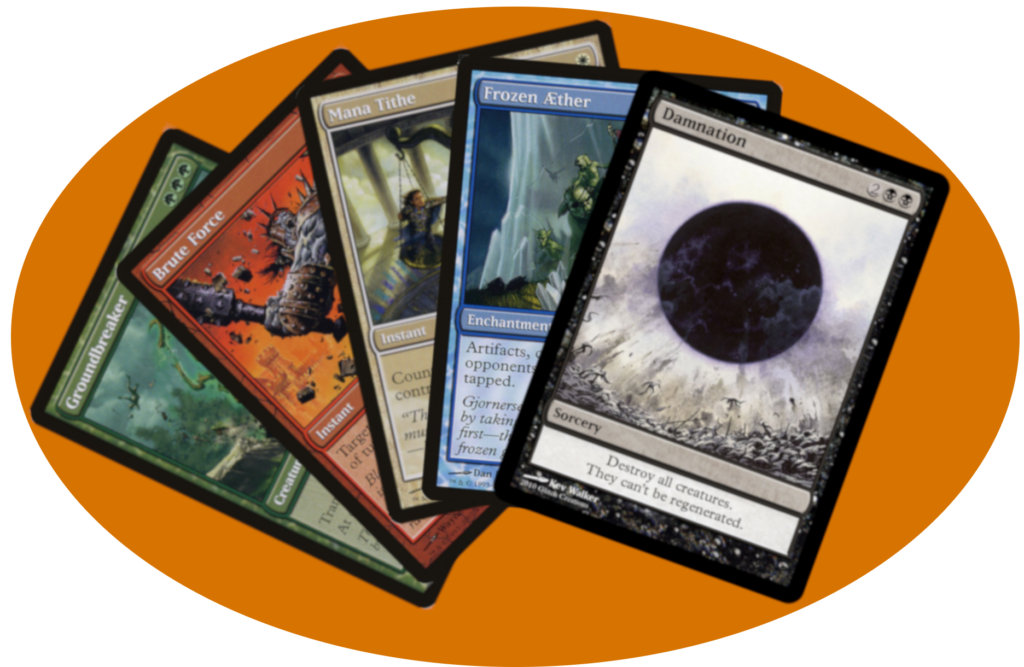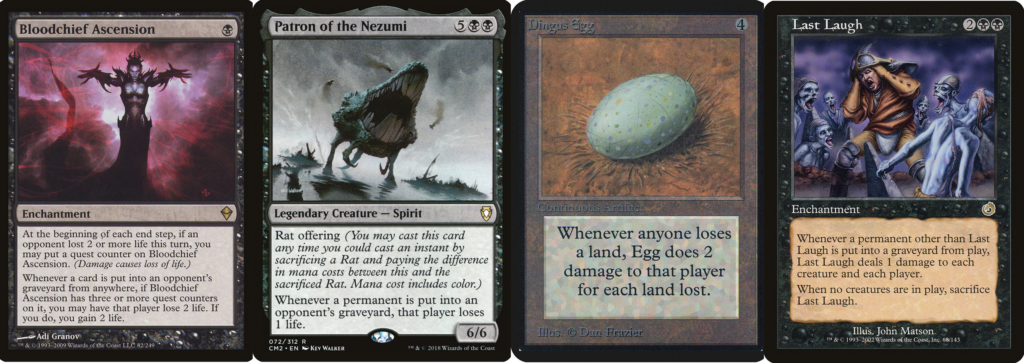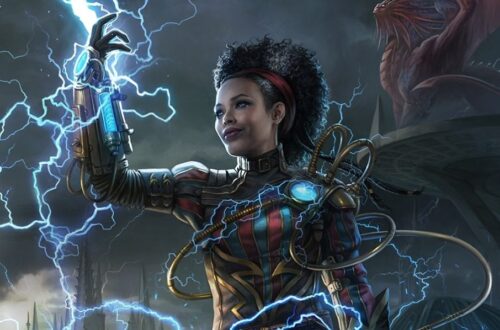MTG: Commander – The Red Button

Every once in awhile, I’ll put up an article about Commander/EDH, my favorite way to play Magic: The Gathering. Today, I want to talk about the EDH deck I’ve been building, on and off, for the better part of 6 years. I’ve mentioned more than a few times here my attempts to make a Land Destruction deck, that isn’t completely unfun, and I think its finally here! Come, and take a look, at the Big Red Button! I’m excited to share it.
The Big Red Button
This, is the big, red, button

The Goal of the deck is, if at all possible, cast this spell and win the game from it. Now, it is a single spell, and I can’t always guarantee that I will have it in hand to win with, so the deck is going to have to function on its own rights in most Games. If I get to cast it one time in five, I’ll be pretty happy.
First things first: The Decklists
Archidekt: https://archidekt.com/decks/591560#The_Red_Button
Tapped Out: https://tappedout.net/mtg-decks/the-red-button/
The Journey to Color Selection
When I’ve built Land Destruction decks over the course of time, I’ve bounced between Rakdos (Red/Black), Jund ( Red/Green/Black), Gruul (Red/Green) and Mardu (Red/White/Black). This has been based on the availability and synergy of the land destruction cards in the deck, and how they combine to make a whole. This has focused on getting the most out of the land destruction cards as individuals entities, creating value within the color set.
This proved both unfun and impossible. While 1v1 Land destruction can often culminate in the painful, if slightly slow, death of the opponent, in the Multiplayer commander format, it’s simply not going to have enough gas and it’s going to irritate all the players in the pod. This simply won’t do.
When I realized that I wanted to win the game on a single land destruction spell, I started considering different conditions on how to do that. I knew that I would need spells that punished my opponent’s lands for going to the graveyard. Of course, this leads me to the old, time tried version: Dingus Egg, and then, I found a few more. I’m still searching to make sure I have them all at least considered ( I know of Liability, though, I’ll get there soon!). These are the four I chose for the deck.

We’ll get to why In a bit here, but I knew that if I hit an obliterate, I wanted at least one of these cards in play. Preferably, to be completely honest, Last Laugh or Bloodchief Ascension, because that the enchantments wouldn’t be part of the obliterate, enabling them to assuredly maintain.
Following this discovery, I started leaning toward Mardu due to the positive synergy it would bring with this sort of deck. I knew that Lifegain, protection, and damage reduction were all part of whites wheelhouse and that those specific abilities would enable me to carry the obliterate plan forward. I knew that these colors would be superior to the previous Jund interactions, mostly due to the Jund deck having a natural desire to become a landfall deck, which wasn’t something I was interested in for this deck.
The Commander
When selecting the commander, I had a pretty solid set of commanders to choose from, going on the EDH rec page here. I didn’t want a tribal deck, so all of those were out (Edgar, Kaalia, Gwun, Jirina). I didn’t want partners (Tyman, Bruse, Ravos, Vialsmasher,Akiri, Silvar,). I didn’t really want any specific theme, so the only real card that stood out to me as helping advance my state was, enjoyably enough, Oros, the Avenger.

This card drops down in the late game, and if I untap with it, it can cause untold destruction. Well. Kinda. For 3 mana he casts [mtg_card]lightning bolt[/mtg_card] on every non-white target. That is great, and because of how the ability is worded, its Oros doing the damage, not something else, and that leads to some cool tricks you can play.
3 damage isn’t often enough when it comes to the commander, and finding great ways to boost that damage to a higher level seemed like something I could easily do. Thankfully, this came on the heels of videos I’d seen about [mtg_card]Torbran, Thane of Red Fell[/mtg_card], and later on, [mtg_card]Obosh, the Prey-piercer[/mtg_card], so I was already considering a red aggro-like damage amplification deck. I knew there were cards like [mtg_card]Furnace of Rath[/mtg_card] I could lean on, and that seemed really strong. Torbran and Furnace out together would be 8 damage to all non-white creatures, and that makes for a huge difference in efficacy for that three mana.
At this point, I finally had a deck core that I was going to build around. I was going to have Oros as the commander, waiting in the wings to deliver a board wipe to any uppity decks that started to get to many creatures onboard. Not having haste is a pain, but it just means that I cast him on 5 or 6, and try to protect him. Backing the dragon up is the big red button, Obliterate, only to be cast when I have the proper pieces locked in place damaging the opponents for what they would have going to the graveyard. I would try and be in an advantageous position first, such that my stuff going to the graveyard either doesn’t kill me, or it doesn’t end up mattering because of stack stacking. Additionally, I would try and have some white preservation magic on tap in order to make sure that I survived even if I wasn’t advantaged. A suite of spells like [mtg_card]Delaying Shield[/mtg_card],[mtg_card]The Wanderer[/mtg_card], [mtg_card]Purity[/mtg_card], and [mtg_card]Avacyn, Angel of Hope[/mtg_card]. This needed Red/White/Black, and this was the direction I’ve decided to pursue.
The Deck Strategy
With the Commander, Colors, and Win Condition, I was set. There was little else I needed in order to be able to build the deck. I could take it a number of ways, each of which would be extremely rewarding in its own right.
- Enchantments: This deck would focus on bestow and constellation to generate value and commit to the knockout blow once obliterate happened
- Voltron: This deck would focus on ramping out Oros and smashing time and again into the opponents to keep the board clear and my creatures alive.
- Indestructible Tribal: This deck would focus on making sure my creatures were able to withstand both Oros and Obliteration to end the game.
- Reanimator: This deck would focus on making sure I had plenty of ways to bring back the creatures I would be inevitably burning to the ground, both in my and the opponent’s graveyards.
- Creature Damage: This deck would focus on cards like [mtg_card]Ashmouth Hound [/mtg_card], eliminating blockers, and putting things like Lacoliths in the deck.
- Deathfeaster: This deck would focus on benefiting from all of the creature’s death that would inevitably happen, either with Obliteration or with Oros.
I chose to go with the Deathfeaster Archetype. I didn’t want to go all aristocrats style and benefit only from my own creatures, as Oros is going to be swinging in as often as he can, hopefully bringing down some utility creatures and problematic creatures of a larger size, hopefully with the aid of the damage pumping spells.
Ok, Enough talk about theoretics. Let’s start breaking down the deck with some patented…
STATS
I stuck as closely to the “tried and true” build for a first run of a commander deck, meaning the below:
- 10 Draw
- 10 Ramp
- 5 board wipe
- 5 targeted Removal
This is followed up by Synergy, Left Field, and Stand-Alone cards. I also have three additional categories: Damage Enablers, Death Protection, and Card Damage.
lets start with the core of the deck
Damage Enablers
[mtg_card]Jaya, Venerated Firemage[/mtg_card]
[mtg_card]Torbran, Thane of Red Fell[/mtg_card]
[mtg_card]Insult//Injury[/mtg_card]
[mtg_card]Obosh, the Prey Piercer[/mtg_card]
[mtg_card]Overblaze[/mtg_card]
[mtg_card]Fiendish Duo[/mtg_card]
[mtg_card]Gisela, Blade of Goldnight[/mtg_card]
This section is fairly large because its the portion of the deck I am relying on the most. I have enough cards here to feel sure I am going to pick one up pretty early and, with patience and care, use it to get the game thundering along. they do work in tandem, but remember that the opponent gets to choose how they suffer damage, so I expect that its double first and then add.
Each of these cards is picked for its own merits. There wasn’t a ton to choose from, true, but these have an upside. Jaya is difficult to deal with planeswalker that is both on-theme and does damage. Her damage is red, odd, and can target players, so it works under all the other circumstances here combining – she’s never going to wish she was another card. Torbran has the opponent clause, which is really helpful, Insult is fairly cheap, and has the option to do extra damage in aftermath form. Obosh cares about odd spells, which is a bit wiggly but making sure it’s only my effects is important. Also, creatures are useful, so having it on a body is pretty Useful. Overblaze is really interesting, in that it targets only a single permanent of mine, which means that I can hit Dingus Egg or even Oros and ramp up the damage. Fiendish Duo doubles damage to opponents, which is ok, but it does suck that it doesn’t help remove their permanents. Lastly, Gisella is just great. She’s a furnace and a damage reducer at the same time, with massive damage potential. I like that almost all of these cards amp up Oros
Death Protection:
[mtg_card]Boros Charm[/mtg_card]
[mtg_card]Delaying Shield[/mtg_card]
[mtg_card]Sustaining spirit[/mtg_card]
[mtg_card]The Wanderer[/mtg_card]
These are all pretty self-explanatory. Each of these is, in its own way, part of the win condition of the deck. Boros Charm makes it so I don’t destroy anything of my own, Delaying shield blocks damage from this turn, Sustaining spirit ensures that the damage I take is eliminated, and the Wanderer simply prevents damage. Wanderer, specifically, is great as it also prevents my creatures from taking damage from Oros.
Graveyard Damage
[mtg_card]Bloodchief Ascension[/mtg_card]
[mtg_card]Dingus Egg[/mtg_card]
[mtg_card]Last Laugh[/mtg_card]
[mtg_card]Patron of the Nezumi[/mtg_card]
We went over these earlier, so I won’t spend a ton of time here.
Game Enders
[mtg_card]Obliteration[/mtg_card]
[mtg_card] Roiling Terrain[/mtg_card] or [mtg_card]Star of Extinction[/mtg_card] +[mtg_card]Radiate[/mtg_card]
These are the desired methods of winning. Obliterate just crushes everything, and if we’ve played it right, we win the game right out. I’ve also got two tutors to dig up whichever of the parts I am missing, and honestly, it might be worth slapping in [mtg_card] Rune-scarred demon [/mtg_card]
For Obliterate, we’d like any of the Death Prevention cards, preferably the enchantments, Dingus Egg or Last Laugh, and a damage increasing card, again preferably an enchantment
With Roiling Terrain, we just need to have any of the death prevention spells, because with radiate it does an ungodly amount of damage. With a damage enhancer out, it becomes absolutely bonkers.
Lastly, Star of Extinction takes a bit more setup, but you’ll need a death Prevention card and Repercussion. It’s going to simply blow out everyone in the game and every creature. It’ll be glorious!
Draw
This deck has the following Draw Suite:
- [mtg_card]Disciple of Bolas[/mtg_card]
- [mtg_card]Shadows of the Past[/mtg_card]
- [mtg_card]Chandra, Torch of Defiance[/mtg_card]
- [mtg_card]Chandra, fire artisan[/mtg_card]
- [mtg_card]The Scorpion God[/mtg_card]
- [mtg_card]Syr Carah, The Bold[/mtg_card]
- [mtg_card]Browbeat[/mtg_card]
- [mtg_card]Explosive revelation[/mtg_card]
- [mtg_card]Outpost siege[/mtg_card]
- [mtg_card]Risk factor[/mtg_card]
- [mtg_card]Sin Prodder[/mtg_card]
- [mtg_card]Theater of Horrors[/mtg_card]
- [mtg_card] Wheel of Fortune[/mtg_card]
This is a few more than we’d expect, but a few of them have dual roles: Chandra and Scorpion God, Syr Carah, and Explosive Revelation are all removal spells. Shadows, Browbeat, Risk Factor, and Sin Prodder all have synergy with other portions of the deck. It’s really excellent to have so many draw cards with dual usage, but there are problems with reds draw, as its generally weaker, being impulsive, so a stronger draw suite works out just fine. Among the best here are Risk Factor, Syr Carah, and Chandra, Torch of Defiance, all of whom interact with the Damage Amplification to create real problems.
Mana Ramp
[mtg_card]Fellwar Stone[/mtg_card]
[mtg_card]Mox Diamond[/mtg_card]
[mtg_card]Orzhov Signet[/mtg_card]
[mtg_card]Sol Ring[/mtg_card]
[mtg_card]Thran Dynamo[/mtg_card]
[mtg_card]Worn Powerstone[/mtg_card]
[mtg_card]Revel in Riches[/mtg_card]
[mtg_card]Knight of the White Orchid[/mtg_card]
[mtg_card]Wayfarers Bauble[/mtg_card]
[mtg_card]Arcane Signet[/mtg_card]
With Obliterate and Oros both being expensive, I wanted to make sure that I’ve gotten some of the quickest mana ramps I could. the only card that is dead early is Revel in Riches, but its both an alternate win condition AND has the possibility of netting a pile of treasure tokens if Oros gets in for a big breath.
Board Wipes
[mtg_card]Obliterate[/mtg_card]
[mtg_card]Balefire dragon[/mtg_card]
[mtg_card]Ruinous Ultimatum[/mtg_card]
[mtg_card]Star of Extinction[/mtg_card]
We’ve already seen two of these, and with Oros, I feel compelled to run fewer board wipes. I really feel like [mtg_card] Inferno [/mtg_card] and [mtg_card] Blasphemous Act [/mtg_card] are good here, but couldn’t find a place I was happy to slot them in. Ruinous Ultimatum is an alternate win condition as well, destroying everything and sending piles of cards to the graveyard for loss of life and potential death.
Balefire dragon and the damage amplifiers can be an extremely important targeted board wipe, but I don’t know that its not simply another Oros.
Targeted Removal
[mtg_card]Chandra, fire artisan[/mtg_card]
[mtg_card]The Scorpion God[/mtg_card]
[mtg_card]Syr Carah, The Bold[/mtg_card]
[mtg_card]Explosive revelation[/mtg_card]
[mtg_card]Enchanter’s bane[/mtg_card]
[mtg_card]Kaervek the Merciless[/mtg_card]
[mtg_card]Boros Charm[/mtg_card]
[mtg_card]Builders Bane[/mtg_card]
[mtg_card]Overseer of the Damned[/mtg_card]
[mtg_card]Patron of the Vein[/mtg_card]
[mtg_card]Chaos Warp[/mtg_card]
[/mtg_card] Hex Parasite[/mtg_card]
I have a plethora of Targeted removal, but thankfully most of them are building on the themes of the deck, filling a number of roles. Of Particular glee, I like the [mtg_card]Hex Parasite[/mtg_card] + [mtg_card]Chandra, Fire Artisan[/mtg_card] play, where – with damage doublers and additives – I can launch a bunch of damage at players faces. Enchanters bane and Chaos warp are my methods of dealing with enchantments, and Enchanter’s bane is generally not great, but in this deck, it can get really tough. 5 cost enchantments can be somewhere in the range of 7-12 life, and I don’t know whats going to warrant taking that much damage. It does have to target itself if no other enchantments are around, so it’s not a preventative. Kaervek is odd cost and red, creating huge problems for opponents. Builders Bane is much less efficient than Vandalblast, but it does do damage, so there are times where doing 3 damage per selectively destroyed artifacts is absolutely going to be worth it. (I have just read the oracle/reprint text and I am sad.. might have to pitch this one – editor)
The Rest of the Deck
These last two cards on the Removal section, along with Revel in Riches, brings us to the cards that benefit us when our opponent’s creatures die. I tried to get the most out of the opponent’s board state as I can easily expunge whole boards and, hopefully, gain benefit to them dying. Cards like Patron of the Vein and Overseer of the Damned, Yahenni, and others.
This deck has been a long time in the making, but it’s likely still not perfect. I’m would LOVE to hear about direct improvements or cards that function in the same vein that I might have missed. This is a deck of passion, and making it work will be a ton of fun!


